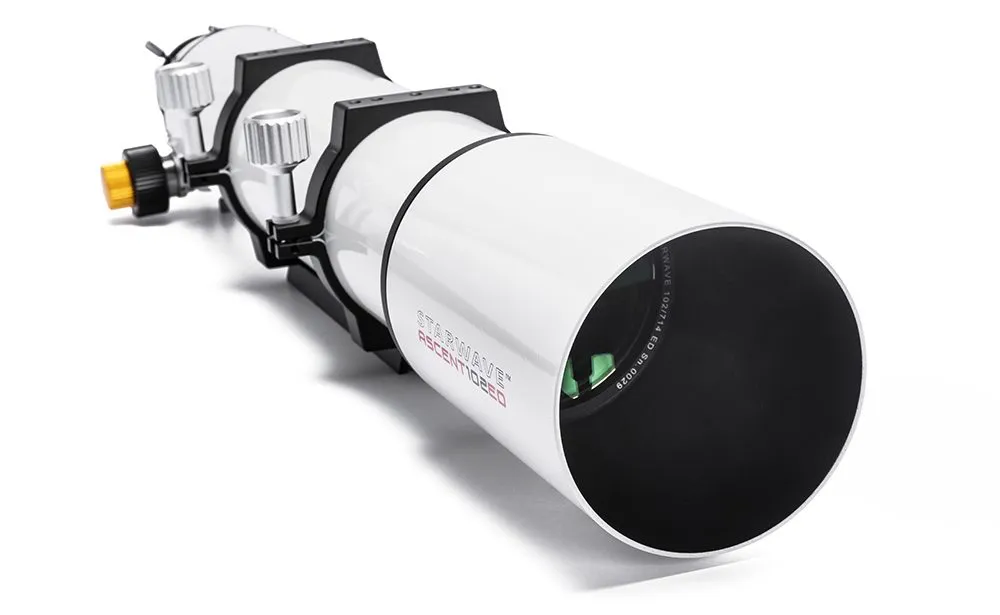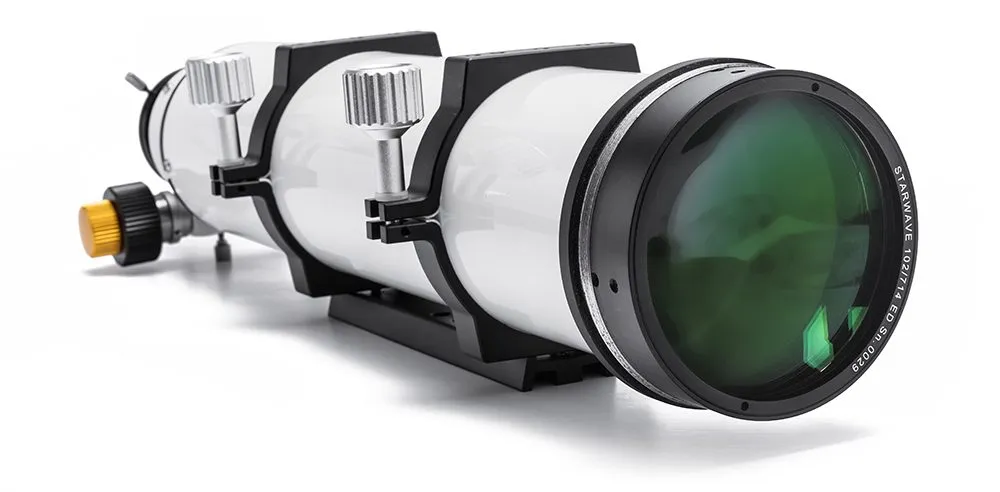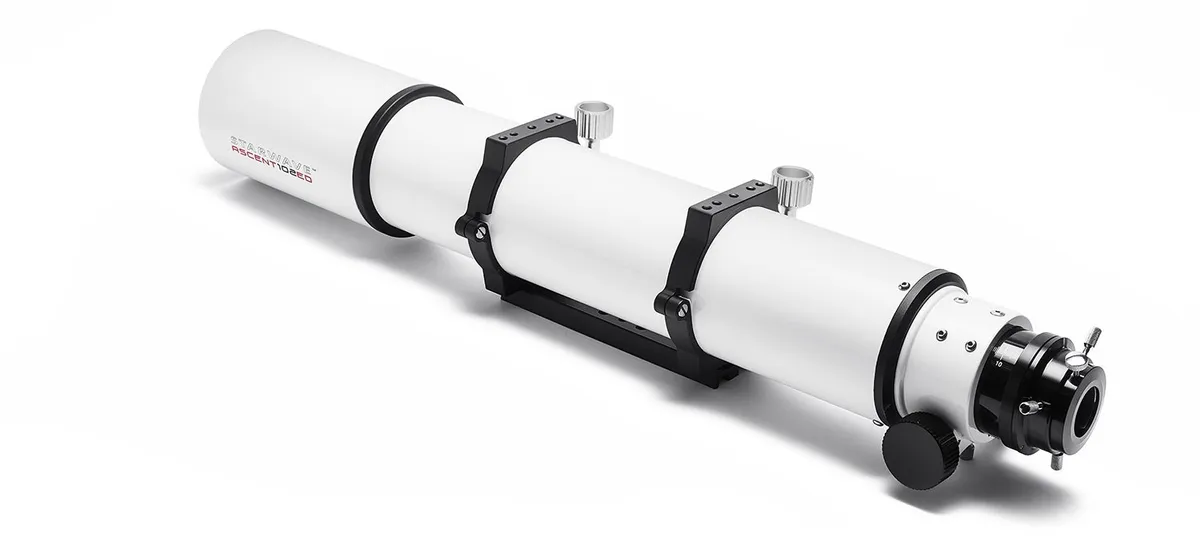Refractors are probably the most often used and sought-after type of telescope, as they are simple to set up and have no mirrors to collimate.
They also have a variety of focal lengths to suit your astronomical needs, be it visual or imaging.
The latest offering from Altair Astro is the Starwave Ascent 102ED, which is available as either an f11 long focus version or the f7 short focus variant we review here.
Looking smart in powdered white with a black finish focuser, the refractor comes as a basic tube with tube rings and a Vixen-style mounting bar, removeable dewshield, 10:1 fine focuser and 1.25- to 2-inch adaptor.
The front objective lens is a doublet configuration, made from ED (extra dispersion) glass and all the surfaces are multi-coated for a crisper view – especially useful for planetary and lunar observation.
The 102mm aperture provides 63 per cent more light-gathering power than an 80mm objective (front lens) which helps to give brighter deep-sky views too.

For our visual tests we mounted the scope on our Sky-Watcher AZ-EQ6 in EQ mode, added our dielectric star diagonal and used our 2-inch and 1.25-inch eyepieces to give a good range of magnification.
In our first clear night the Moon was high in the sky, but that didn’t stop us testing the quality of the field of view by using the star Procyon in Canis Minor.
For this we used our 2-inch, 21mm Tele Vue Ethos eyepiece and enjoyed a spectacular view as we moved Procyon from one side to the other in the eyepiece.
We enjoyed a crisp view of the star, across 90% of the field of view, before slight distortion began to show.
Next, we took a tour of a variety of coloured stars – including Capella, Betelgeuse, Pollux and Aldebaran – to assess the colour rendition and we were pleased with the Ascent 102ED’s crisp views and colour.
The Moon was sharp and full of detail with no sign of chromatic aberration (blurring with coloured edges) on the bright edge of the limb.
Chromatic aberration happens when colours don’t all come to the same focus, so we were pleased to see it well controlled.
After a thrilling tour across the lunar landscape with our 26mm eyepiece, we added our 2x Barlow lens to view more detail.
During moments when seeing conditions were good, the floor of the crater Plato was revealed as smooth, but with indications of small craters popping into view.
Our Canon EOS 50D DSLR captured a nice view of the Moon, but it was a little on the small side at f/7.
Swapping to our Altair Astro GPCAM2 290c colour camera, we captured several videos of the southern and northern hemispheres of the lunar landscape to produce crisp detailed images of the area covering Clavius and Tycho.
The focuser held our various imaging cameras with no slippage and we were able to test plenty of accessories.

Sadly, the best planets – Jupiter and Saturn – were too low along the ecliptic for us to view, but we did manage to see Mars, despite its small disk, and there was a polar cap and some subtle surface markings for us to enjoy.
We had to wait almost to the end of our review period for a night with no Moon and one of the clearest, darkest skies we’ve had recently for a deep-sky appraisal.
Again, we took a visual tour of the night sky’s main delights, taking in wide-field views of the Sword of Orion, using the Tele Vue Ethos 21mm eyepiece, with lots of nebulosity on show in the Orion Nebula.
The Pleiades star cluster, M45, sparkled like diamonds on black velvet, with the Merope Nebula just viewable with averted vision.
The Andromeda Galaxy, M31, was a little low down but we could see the faint disk stretching across a large part of the almost 3˚ wide field of view and the companion galaxies were prominent.
Adding the DSLR camera we took images of the Sword of Orion and the Leo Triplet of galaxies.
They showed reasonable colour correction, since imaging is always more demanding compared with visual, although we did note a little blurry chromatic aberration.
Overall, however, the Ascent 102ED f/7 performed well and would make an excellent addition to your equipment collection.
Easy on the eye
The lightweight body of the scope made it easy to set up on our chosen mount, whether we were viewing or imaging.
The quality of the views impressed us as we could add in higher magnification eyepieces and still get rewarding vistas, be it with the Moon or galaxies.
To test the resolving power, we viewed the double stars of Algieba and Castor with our 9mm eyepiece, easily splitting them into their component stars with good colour contrast, especially Algieba. Adding in the x2 Barlow lens and our Altair GPCAM2 290C camera we achieved our best images of both pairs with a clean, clear space between the stars.
The Moon has lots of fine detail, so we used the same camera combination to close in the crater Clavius.
We were rewarded when we stacked 1,500 frames out of over 5,000, to get a crisp view of the small craters inside it.
The higher magnification views of galaxy M82 also picked out the darker breaks in its disk, all making it an enjoyable viewing experience.

Optics
The front objective lens element sits in a collimatable cell. It’s a doublet lens with multi-coatings on all its optical surfaces, allowing for good control of colour correction.
The lens is 102mm in diameter with a focal length of 714mm, giving a focal ratio of f/7. It’s ideal for visual and imaging purposes.
Body
The tube is machined aluminium, 73cm long and weighing just 4kg, making it lightweight and easy to use.
It cools down quickly, enabling you to be up and viewing or imaging quickly, which is helpful for taking advantage of those occasional clear patches of sky.
Tube rings
The two tube rings gave firm grip yet could be loosened to rotate the tube if needed for a better imaging orientation.
They have M6 mounting holes for attaching additional equipment such as a guide scope, while attachment to a mount is via the Vixen dovetail bar.
Focuser
The focuser is a smooth, dual-speed, non-slip 2.5-inch geared unit with 93mm of travel and a tension adjustment screw underneath.
The tension screw allows for heavy equipment such as large cameras to be attached and locked off, so the focus doesn’t slip during imaging.
Dew shield
The metal dewshield is 200cm in length and 12cm in diameter, and can be unscrewed for lens cleaning.
Its internal surface is a matt black, cutting down on extraneous light and it worked well under damp conditions, allowing time for viewing and imaging before the lens showed signs of dew.

Vital stats
- Price £549
- Optics Fully multi-coated ED doublet lens in collimatable cell
- Aperture 102mm
- Focal length 714mm; f/7
- Mount Tube ringswith Vixen dovetail bar
- Focuser 10:1 fine focus 2.5-inch focuser, with 93mm of travel
- Weight 4Kg
- Extras Removable dew shield; 2-inch to 1.25-inch adaptor; front and backdust caps
- Supplier Altair Astro
- Tel01263 731505
- www.altairastro.com
This review originally appeared in the May 2019 issue of BBC Sky at Night Magazine
